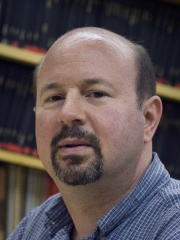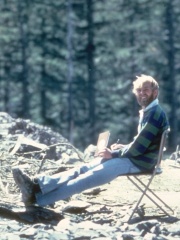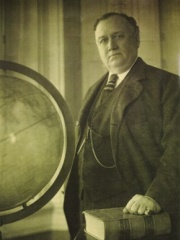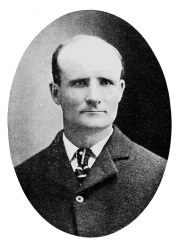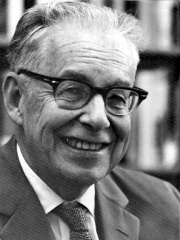
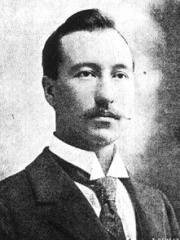


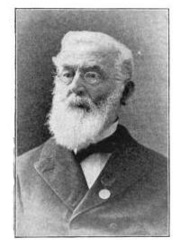
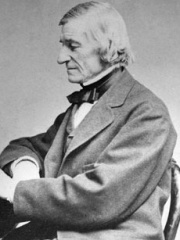
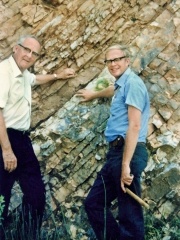
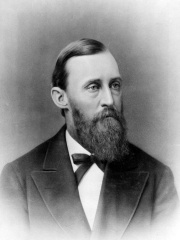
The Most Famous
GEOLOGISTS from United States
This page contains a list of the greatest American Geologists. The pantheon dataset contains 90 Geologists, 13 of which were born in United States. This makes United States the birth place of the 2nd most number of Geologists.
Top 10
The following people are considered by Pantheon to be the top 10 most legendary American Geologists of all time. This list of famous American Geologists is sorted by HPI (Historical Popularity Index), a metric that aggregates information on a biography’s online popularity. Visit the rankings page to view the entire list of American Geologists.

1. Charles Francis Richter (1900 - 1985)
With an HPI of 67.82, Charles Francis Richter is the most famous American Geologist. His biography has been translated into 62 different languages on wikipedia.
Charles Francis Richter (; April 26, 1900 – September 30, 1985) was an American seismologist and physicist. He is the namesake and one of the creators of the Richter magnitude scale, which, until the development of the moment magnitude scale in 1979, was widely used to quantify the size of earthquakes. Inspired by Kiyoo Wadati's 1928 paper on shallow and deep earthquakes, Richter first used the scale in 1935 after developing it in collaboration with Beno Gutenberg; both worked at the California Institute of Technology.

2. Barnum Brown (1873 - 1963)
With an HPI of 51.90, Barnum Brown is the 2nd most famous American Geologist. His biography has been translated into 31 different languages.
Barnum Brown (February 12, 1873 – February 5, 1963), commonly referred to as Mr. Bones, was an American paleontologist. Named after the circus showman P. T. Barnum, he discovered the first documented remains of Tyrannosaurus during a career that made him one of the most famous fossil hunters working from the late Victorian era into the early 20th century.

3. Harry Hammond Hess (1906 - 1969)
With an HPI of 51.05, Harry Hammond Hess is the 3rd most famous American Geologist. His biography has been translated into 23 different languages.
Harry Hammond Hess (May 24, 1906 – August 25, 1969) was an American geologist and a United States Navy officer in World War II who is considered one of the "founding fathers" of the unifying theory of plate tectonics. He published theories on sea floor spreading, specifically on relationships between island arcs, seafloor gravity anomalies, and serpentinized peridotite, suggesting that the convection in the Earth's mantle is the driving force behind this process.

4. Niles Eldredge (b. 1943)
With an HPI of 49.08, Niles Eldredge is the 4th most famous American Geologist. His biography has been translated into 20 different languages.
Niles Eldredge (; born August 25, 1943) is an American biologist and paleontologist, who, along with Stephen Jay Gould, proposed the theory of punctuated equilibrium in 1972.

5. Hugo Benioff (1899 - 1968)
With an HPI of 47.98, Hugo Benioff is the 5th most famous American Geologist. His biography has been translated into 18 different languages.
Victor Hugo Benioff (September 14, 1899 – February 29, 1968) was an American seismologist and a professor at the California Institute of Technology. He is best remembered for his work in charting the location of deep earthquakes in the Pacific Ocean. Benioff was born in Los Angeles. His father was a Jewish immigrant from Kyiv in the Russian Empire and his mother a Lutheran from Sweden. After graduating from Pomona College in 1921, Benioff began his career with the idea of being an astronomer and worked for a time at Mount Wilson Observatory, but when he found that astronomers work at night and sleep in the daytime, he quickly switched to seismology. He joined the Seismological Laboratory in 1924 and received his Ph.D. from the California Institute of Technology in 1935. Benioff is noted as a pioneer in the design of earthquake instruments. One of his first instruments, created in 1932, was the Benioff seismograph, which senses the movement of the earth – these instruments are now used in every country in the world. Equally famous is the Benioff strain instrument, which records the stretching of the Earth's surface. One of his most recent accomplishments was a refined version of the old Benioff seismometer which has given seismologists more knowledge about the cause of very deep earthquakes. Benioff noticed that earthquake sources get deeper under the overriding tectonic plate proceeding away from the trench at a subduction zone. He realized that this inclined array of earthquake sources indicate the position of the portion of the plate that has already been subducted. Thus, that pattern of earthquakes is known as a Wadati–Benioff zone. From the early 1930s, Benioff also worked on creating electric musical instruments; in particular a piano, violin and cello. He continued developing these instruments for the rest of his life, working for over two decades with pianist Rosalyn Tureck and also, towards the end of his life with the Baldwin Piano Company. He was elected a Fellow of the American Academy of Arts and Sciences in 1958. Also in the same year he was elected as President of Seismological Society of America (1958).

6. James Hall (1811 - 1898)
With an HPI of 47.17, James Hall is the 6th most famous American Geologist. His biography has been translated into 18 different languages.
James Hall Jr. (September 12, 1811 – August 7, 1898) was an American geologist and paleontologist. He was a noted authority on stratigraphy and had an influential role in the development of paleontology in the United States.

7. William Barton Rogers (1804 - 1882)
With an HPI of 46.33, William Barton Rogers is the 7th most famous American Geologist. His biography has been translated into 16 different languages.
William Barton Rogers (December 7, 1804 – May 30, 1882) was an American geologist, physicist, and educator at the College of William & Mary from 1828 to 1835 and at the University of Virginia from 1835 to 1853. In 1861, Rogers founded the Massachusetts Institute of Technology. The university opened in 1865 after the American Civil War. Because of his affiliation with Virginia, Mount Rogers, the highest peak in the state, is named after him.

8. Walter Alvarez (b. 1940)
With an HPI of 45.65, Walter Alvarez is the 8th most famous American Geologist. His biography has been translated into 23 different languages.
Walter Alvarez (born October 3, 1940) is a professor in the Earth and Planetary Science department at the University of California, Berkeley. He and his father, Nobel Prize–winning physicist Luis Alvarez, developed the theory that dinosaurs were killed by an asteroid impact.

9. Ferdinand Vandeveer Hayden (1829 - 1887)
With an HPI of 45.63, Ferdinand Vandeveer Hayden is the 9th most famous American Geologist. His biography has been translated into 15 different languages.
Ferdinand Vandeveer Hayden (September 7, 1829 – December 22, 1887) was an American geologist noted for his pioneering surveying expeditions of the Rocky Mountains in the late 19th century. He was also a physician who served with the Union Army during the Civil War.
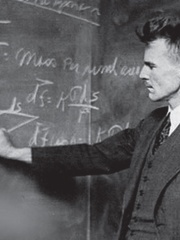
10. M. King Hubbert (1903 - 1989)
With an HPI of 45.32, M. King Hubbert is the 10th most famous American Geologist. His biography has been translated into 18 different languages.
Marion King Hubbert (October 5, 1903 – October 11, 1989) was an American geologist and geophysicist. He worked at the Shell research lab in Houston, Texas. He made several important contributions to geology, geophysics, and petroleum geology, most notably the Hubbert curve and Hubbert peak theory (a basic component of peak oil), with important political ramifications. He was often referred to as "M. King Hubbert" or "King Hubbert".
People
Pantheon has 16 people classified as American geologists born between 1804 and 1965. Of these 16, 4 (25.00%) of them are still alive today. The most famous living American geologists include Niles Eldredge, Walter Alvarez, and Judith Curry. The most famous deceased American geologists include Charles Francis Richter, Barnum Brown, and Harry Hammond Hess. As of April 2024, 2 new American geologists have been added to Pantheon including William Barton Rogers, and Ferdinand Vandeveer Hayden.
Living American Geologists
Go to all RankingsNiles Eldredge
1943 - Present
HPI: 49.08
Walter Alvarez
1940 - Present
HPI: 45.65
Judith Curry
1953 - Present
HPI: 43.72
Michael E. Mann
1965 - Present
HPI: 32.57
Deceased American Geologists
Go to all RankingsCharles Francis Richter
1900 - 1985
HPI: 67.82
Barnum Brown
1873 - 1963
HPI: 51.90
Harry Hammond Hess
1906 - 1969
HPI: 51.05
Hugo Benioff
1899 - 1968
HPI: 47.98
James Hall
1811 - 1898
HPI: 47.17
William Barton Rogers
1804 - 1882
HPI: 46.33
Ferdinand Vandeveer Hayden
1829 - 1887
HPI: 45.63
M. King Hubbert
1903 - 1989
HPI: 45.32
David A. Johnston
1949 - 1980
HPI: 45.08
Daniel Barringer
1860 - 1929
HPI: 44.35
Thomas Chrowder Chamberlin
1843 - 1928
HPI: 44.25
John Bell Hatcher
1861 - 1904
HPI: 41.21
Newly Added American Geologists (2024)
Go to all RankingsOverlapping Lives
Which Geologists were alive at the same time? This visualization shows the lifespans of the 12 most globally memorable Geologists since 1700.


